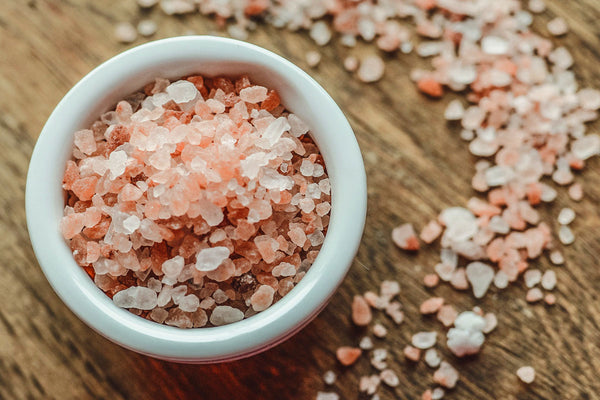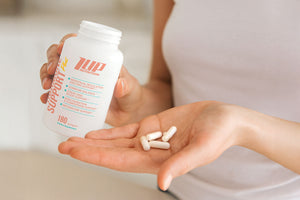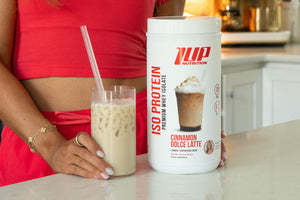Sodium is an essential mineral the body requires to function properly.
Within the body, its primary function is as an electrolyte, where it helps maintain the appropriate balance of fluids in the body.
Additionally, sodium also helps transmit nerve impulses, impacts blood pressure, and affects the contraction and relaxation of muscles.[1] It also facilitates nutrient transport across cell membranes, which makes it essential for absorbing nutrients from the food we eat.[2]
The most common way in which we intake sodium is in the form of salt (sodium chloride).
Complicating matters is the fact that there isn’t just one form of sodium. There’s multiple.
Here are a few of the most common forms of salt you’ll encounter:
- Table salt
- Sea salt
- Himalayan pink salt
- Kosher salt
Note: Sea salt, himalayan salt, and kosher salt are often marketed to be “healthier” than regular salt, but there is no evidence backing these marketing claims.
Sodium can also be found in high amounts in various foods common to the diet, including:
- Soy sauce
- Packaged goods (cereals, bread, crackers, etc.)
- Fried foods
- Processed meats
- Fast food
- Takeout
The reason that salt is found in copious amounts in a lot of pre-made food is that it helps preserve food, and it also enhances the flavor.
Sodium is Essential, But Be Careful
Despite the fact that our bodies do require some sodium to function optimally and support health, you can have too much.
More and more people are relying on processed, frozen, and pre-made foods to fulfill their daily nutrition needs. As such, many adults consume significantly more than the daily recommended intake of sodium.
Current estimates suggest that the human body only needs ~186 mg of sodium per day to function properly. However, the American Heart Association (AHA) notes that the minimum physiological requirement for sodium is ~500 mg a day.
This is the amount contained in ~1/4 teaspoon of table salt.[11]
The USDA, the US Department of Health and Human Services, and the Institute of Medicine (IOM) recommend that healthy adults limit their sodium intake to <2,300mg (2.3 grams) per day, roughly the amount of one teaspoon of salt.[3]
However, research notes that most Americans consume substantially more sodium than is recommended, averaging ~3,400mg (3.4 grams) per day.[4]
Consuming too much sodium may have potential hazardous consequences for your health, as numerous studies have found anassociation between high sodium intake and high blood pressure, heart disease, and kidney disease.[5,6,7]
But...
As scary as that sounds, it’s important to note that these recommendations have been disputed in recent years.
Newer research suggests that consuming less than 2,500mg of sodium per day may actually be associated with higher blood pressure.[8,9]
In fact, researchers who analyzed more than 2,600 men and women over the course of 16 years observed that individuals with the lowest blood pressure levels had higher intakes of sodium and potassium while those with higher blood pressure readings consumed less sodium and potassium.[8]
Another study from 2018 which followed 94,000 people from across the globe for an average of eight years only found evidence of an increased risk of cardiovascular disease and stroke when individuals exceeded 5,000mg of sodium a day -- twice the current recommendation![9]
Furthermore, consuming too little sodium is not good either, as it can lead to:
- Muscle weakness
- Poor appetite
- Muscle cramps
- Impaired cognitive function,
- Headache
- Swelling
Now, it should be mentioned that not everyone responds to sodium intake the same way.
For instance, certain individuals with high blood pressure, diabetes and/or chronic kidney disease (CKD) tend to be more sensitive to the hypertensive (blood pressure-raising) effects of sodium.[10]
At the same time, it’s important to remember that these sodium intake recommendations are made for the general population (i.esedentary individuals who don’t regularly exercise, eat a lot of processed food, and carry extra body fat).
Healthy individuals, especially those that are physically active, likely have higher sodium requirements.
If you train with great intensity on a regular basis and/or work in a very hot environment, you need to make sure that you’re consuming enough sodium daily.
For instance, research indicates that individuals who work in hot environments for 10 hours can lose between 4,800-6,000mg of sodium per day![12]
Additional large population studies suggest that as long as individuals are not regularly consuming over and above 5,000mg of sodium per day that you are not at a significantly increased risk for major cardiovascular events (heart attack and stroke.[13]
The takeaway here is that sodium is neither inherently good or bad.
Your body needs a minimum amount of sodium to function properly each day. How much more than that minimum amount is safe for consumption depends on a multitude of factors including age, genetics, environment, physical activity, and diet.
If you’re highly active and have no pre-existing conditions, then you likely do not need to be concerned with sodium intake. What’s more, you may actually benefit from slightly higher intakes due to how much sodium is lost during intense training.
Due to the importance that sodium plays in supporting athletic performance and resisting fatigue and cramping, it’s frequently included in intra-workout, and post-workout supplements to replace what is lost during training or while working in hot conditions.
At the same time, if you’re not very active, and/or already consuming a high amount of dietary sodium, you may want to consider reducing your intake of sodium-heavy / salty foods.
Up next, we discuss 5 simple ways to reduce sodium intake for those of you interested in scaling back your salt consumption.
5 Ways to Reduce Sodium Intake
Eat Less Processed Food
These days we rely on restaurants, takeout, and meal prep services more than ever.
While these options make it easier to get food quickly, it also significantly increases your sodium intake.
The reason for this is that salt both helps flavor food and preserves it, which increases its shelf life.
The single biggest thing you can do to reduce your sodium intake is to stop relying on packaged or processed foods in your daily diet.
Even perceived “healthy” foods (soups, vegan burritos, etc.) are typically packed with sodium.
Fresh foods contain very little sodium, and when you cook your own food, you can control how much (or how little) sodium you add to it.
For instance, a plain baked potato contains ~12 mg of sodium.
However, when that same potato is turned into a bag of potato chips, that same amount of potato can contain upwards of 500mg of sodium!
Reducing your intake of pre-made foods is the biggest thing you can do to start lowering your salt intake.
Eat More Fruits and Vegetables
Building on the previous point, in addition to cutting back on the number of packaged, pre-made foods you eat each day, you can also start adding more fresh foods into your diet, such as fruits and vegetables.
These foods contain very little sodium by nature, and at the same time, they also contain high levels of other beneficial vitamins and minerals, such as potassium, which acts as a “counterbalance” of sorts to potassium in the body.
FYI, sodium is the electrolyte that balances extracellular water concentrations in the body, while potassium regulates fluid balanceinside the cell.
Also, be aware that canned fruits and vegetables typically contain added salt and/or sugar to increase their shelf-life and prevent spoilage.
Ask for Reduced Sodium or Low-Salt Dishes at Restaurants
As we stated before, salt makes food taste good, and it’s a big part of the reason why dishes at restaurants taste so delicious (that and the copious amounts of oil/butter used to cook the food).
For example, pasta dishes at chain restaurants are notorious for containing over 1,000mg of sodium per serving!
Given the elevated “health consciousness” of consumers, most restaurants nowadays are willing to grant a customer’s special request (low/no-salt, no oil, baked vs fried, etc).
The next time you are out to eat, simply ask the waiter if the dish can be made with less salt (or no salt at all so you can add as little or as much as you want on your own), and they will likely accommodate your request.
If the server seems hesitant, casually mention that you’re willing to tip generously for them obliging your request.
Buy Reduced Sodium Foods from the Store
In addition to asking for lower sodium dishes at restaurants, you can also seek out low-sodium alternatives of your favorite foods at the store.
These days it is rather easy to find low or reduced-sodium versions of common household products like juices, soups, chips, crackers, and cookies.
By law, for a product to be labeled low-sodium, it must contain 140mg or less of sodium per serving.
Additionally, the “reduced sodium” label means that a food must contain 75% less sodium than its full sodium version.
Lightly salted products must contain 25% less sodium than the full sodium variety.
Sodium-free packaged goods must contain less than 5mg sodium per serving.
Finally, “no salt” products are self-explanatory...they must contain no added salt., and no salt added products don’t have any salt added.
Use Salt-Free Seasonings
While salt is a common flavoring of many dishes, many people tend to be a little too liberal with the salt shaker when cooking at home.
Instead of using as much salt in your recipes, try adding more spices, herbs, and acids (lemon juice, lime juice, etc.) to your culinary creations.
These additions are sodium-free and add intriguing tasting elements to your dishes, including warmth, freshness, heat, warmth, and brightness.
Herbs and spices can elevate an otherwise mundane, bland dish into one that tantalizes the palate.
References
- Strazzullo P, Leclercq C. Sodium. Adv Nutr. 2014;5(2):188–190. Published 2014 Mar 1. doi:10.3945/an.113.005215
- Steadman, R. H., Braunfeld, M., & Park, H. (2019). 31 - Liver and Gastrointestinal Physiology. In H. C. Hemmings & T. D. B. T.-P. and P. for A. (Second E. Egan (Eds.) (pp. 630–644). Philadelphia: Elsevier. https://doi.org/https://doi.org/10.1016/B978-0-323-48110-6.00031-4
- Institute of Medicine. 2005. Dietary Reference Intakes for Water, Potassium, Sodium, Chloride, and Sulfate. Washington, DC: The National Academies Press. doi: 10.17226/10925.
- Americans, F. O. R. (2020). DIETARY GUIDELINES.
- Strazzullo P, D’Elia L, Kandala NB, Cappuccio FP. Salt intake, stroke, and cardiovascular disease: meta-analysis of prospective studies. BMJ. 2009;339:b4567.
- Veglio F, Paglieri C, Rabbia F, Bisbocci D, Bergui M, Cerrato P. Hypertension and cerebrovascular damage. Atherosclerosis. 2009;205(2):331–341.
- Manolio TA, Olson J, Longstreth WT. Hypertension and cognitive function: pathophysiologic effects of hypertension on the brain. Curr Hypertens Rep. 2003;5(3):255–261.
- Moore, L. L., Singer, M. R., & Bradlee, M. L. (2017). Low Sodium Intakes are Not Associated with Lower Blood Pressure Levels among Framingham Offspring Study Adults. The FASEB Journal , 31(1 Supplement), 446.6-446.6. Retrieved from http://www.fasebj.org/content/31/1_Supplement/446.6.abstract
- Mente, A., O’Donnell, M., Rangarajan, S., McQueen, M., Dagenais, G., Wielgosz, A., Yusuf, S. (2018). Urinary sodium excretion, blood pressure, cardiovascular disease, and mortality: a community-level prospective epidemiological cohort study. The Lancet, 392(10146), 496–506. https://doi.org/10.1016/S0140-6736(18)31376-X
- Rust, P., & Ekmekcioglu, C. (2017). Impact of Salt Intake on the Pathogenesis and Treatment of Hypertension. Advances in Experimental Medicine and Biology, 956, 61–84. https://doi.org/10.1007/5584_2016_147
- "How Much Sodium Should I Eat Per Day?" Www.heart.org, www.heart.org/en/healthy-living/healthy-eating/eat-smart/sodium/how-much-sodium-should-i-eat-per-day
- Bates, Graham P, and Veronica S Miller. Sweat Rate and Sodium Loss during Work in the Heat. Journal of Occupational Medicine and Toxicology (London, England) 3 (2008): 4. PMC. Web. Jan. 2017.
- Mente, A., O’Donnell, M., Rangarajan, S., McQueen, M., Dagenais, G., Wielgosz, A., Yusuf, S. (2018). Urinary sodium excretion, blood pressure, cardiovascular disease, and mortality: a community-level prospective epidemiological cohort study. The Lancet, 392(10146), 496–506. https://doi.org/10.1016/S0140-6736(18)31376-X






